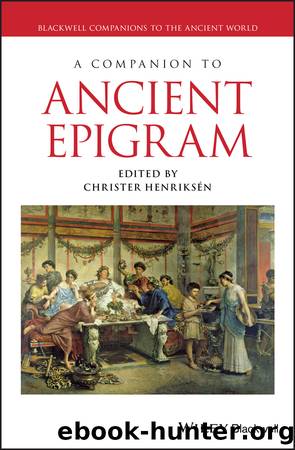A Companion to Ancient Epigram by Henriksén Christer;

Author:Henriksén, Christer; [Henriksèn, Christer]
Language: eng
Format: epub
Publisher: John Wiley & Sons, Incorporated
Published: 2019-01-07T00:00:00+00:00
You are saving your virginity. But to what profit? For after you arrive
in Hades you will not find someone to love you, girl.
The pleasures of Aphrodite are among the living; in Acheron
we shall lie, maiden, as bones and ash.
Here the point depends in large part on the poemâs engagement with an idea that appears commonly in inscribed epitaphs for young women who have died before marrying, namely that their demise constitutes a âmarriageâ to the god of the Underworld. The speakerâs claim that âgoing to Hadesâ the girl will not find her lover plays on the polyvalence of Hades as a metonym for the Underworld and the name of the god (cf. Cairns 1993 and 1996). In this sense, the relationship between form and content is essential to the meaning: the poem has a length and metrical structure that would befit an inscribed epitaph, but turns a basic commonplace of sepulchral poetry to a very different end.
Several epigrams are constructed in such a way that they resist easy generic categorization. Perhaps most striking is an epigram celebrating the Colophonian courtesan Archeanassa (41â=âAP 7.217). The opening words of this epigram âI hold Archeanassaâ leave the character of the speaker ambiguous, since they would be equally appropriate as coming from the voice of her tomb or of her lover â or, put another way, the tomb of Archeanassa speaks as if it were her lover, and in this context the speakerâs treatment of the heat of passion experienced by her former lovers as a âpyreâ serves as a hinge that blends the two ideas at the conclusion of the poem. Similarly, in 21, the addressee might equally be a young man or an image of one. Whether the poem is âecphrasticâ or âamatoryâ is thus ambiguous, as is the speakerâs relationship to the addressee: is he a wouldâbe lover, or an appreciative art critic?
Such poems invite the reader to participate actively in reconstructing the imagined circumstances, and the challenge and fun reside in the difficulty of determining precisely who or what is speaking, and in what context: one of the most distinctive features of Asclepiadesâ poetry is the way in which it plays with voice. In a basic sense, he is in this regard typical of the epigrammatists of the early Hellenistic period, who regularly exploited in creative ways the variability and mutability of voice inherent in inscribed epigrams from the earliest period. Thus, for example, 28 (AP 7.11), adopts the formal features of epitaphs that open by asserting, âthis is the tomb ofâ of such and such a person, though in this case the speaker is the âlaborâ of the poetess of Erinna, so that the poem makes its imaginary physical context not an inscribed tomb but a papyrus roll containing Erinnaâs verse. At the same time, the epigram exploits the tendency of inscribed funerary epigrams to shift between the voice of the tomb and that of the deceased, as already in a sixthâcentury Attic epitaph for the virgin Phrasicleia (CEG
Download
This site does not store any files on its server. We only index and link to content provided by other sites. Please contact the content providers to delete copyright contents if any and email us, we'll remove relevant links or contents immediately.
Hebrews, James by George H. Guthrie & George H. Guthrie(452)
Ideology by Eagleton Terry;(444)
Israel: Ancient Kingdom or Late Invention? by Daniel I. Block(442)
The 9.9 Percent by Matthew Stewart(421)
Take Back Your Time by Christy Wright(411)
The New Oxford Annotated Bible with Apocrypha by unknow(409)
Eating the Bible by Rena Rossner(404)
Insights on Hebrews by Charles R. Swindoll(401)
The Book Every Leader Needs to Read by 48 Authors(397)
Psalms, Proverbs, Ecclesiastes, and Song of Songs by John W. Hilber & Tremper Longman III & Duane Garrett(369)
Commentary on the Torah by Richard Elliott Friedman(346)
Commentary on James (Commentary on the New Testament Book #16) by Robert H. Gundry(344)
Judges: Volume Two by unknow(339)
The Jew in the Lotus by Rodger Kamenetz(336)
Who Wrote the Bible? by Richard Elliott Friedman(334)
NKJV, Ignite, eBook by Thomas Nelson(330)
Job, Ecclesiastes, Song of Songs by August H. Konkel & Tremper Longman III(328)
Proverbs, Ecclesiastes, Song of Solomon (Ancient Christian Commentary on Scripture) by J. Robert Wright(324)
Reading the Bible with Rabbi Jesus by Tverberg Lois(307)
